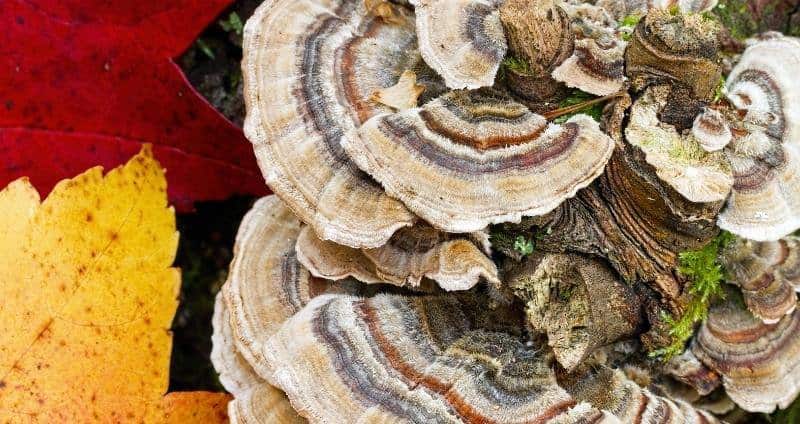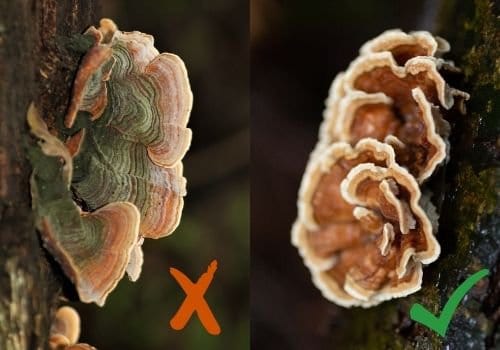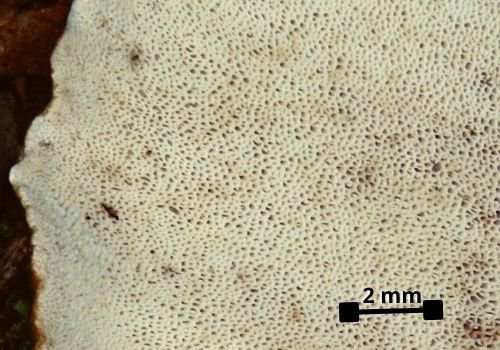Turkey tail mushrooms are among the primary saprophytes (fungi that grow on dead matter) that attack and decompose rotting wood. It’s, therefore, no wonder that these polypore mushrooms are most commonly found on fallen logs or tree stumps.
Though these mushrooms (fruiting bodies) can also be found on living trees, they mostly grow among other mushroom saprophytes, such as the false turkey tail fungus. For this reason, you need to learn how to correctly identify turkey tail mushrooms and avoid look-alikes.
Fortunately, turkey tail mushrooms do not have toxic look-alikes, which generally makes them a “safe” mushroom to forage.
Similar mushrooms, however, lack the health-supporting compounds that these functional mushrooms are known and valued for.
To help you correctly identify the true turkey tail, and to give you some helpful facts about this mushroom and its uses, we’ll answer these 11 questions:
We’ll also discuss some ways to consume turkey tail, including which way is best for getting maximum potency from it. Let’s first identify the most common look-alikes.
With its banded colors and fan-like shape, the false turkey tail mushroom bears an uncanny resemblance to the edible turkey tail fungus. But just because they look so similar, is false turkey tail also edible?
The short answer is no. False turkey tail mushrooms are not considered edible. They have a tough, leathery texture and no known nutritional benefits. Additionally, the safety of eating them is uncertain.
What is False Turkey Tail?
False turkey tail refers to several species of fungi in the genus Stereum. The most common ones are Stereum ostrea, Stereum hirsutum, and Stereum complicatum.
Like turkey tail mushrooms, these fungus species grow as colorful shelving mushrooms on decaying logs and trees. Their caps have distinct zones of brown, orange, yellow, and sometimes green.
On the underside, rather than pores, false turkey tails have a smooth pore surface. Their texture is hard and leathery, making them inedible.
Why False Turkey Tail is Considered Inedible
There are a few key reasons why mushroom enthusiasts agree that false turkey tail fungi should not be eaten:
-
Tough, leathery texture – The caps of false turkey tails are too tough to eat when raw or cooked. Chewing and digesting them would be difficult.
-
No nutritional value – Unlike turkey tail mushrooms, false turkey tails contain no known nutritional compounds, vitamins, or minerals There is no benefit to eating them
-
Safety concerns – There is limited research on the edibility and toxicity of false turkey tails. It is better to avoid eating unknown species. Consuming them could potentially cause stomach upset or worse.
-
Lack of flavor – With their fibrous texture and no distinctive taste, false turkey tails do not make for good eating compared to other edible mushrooms.
Essentially, false turkey tails have none of the benefits of genuine turkey tails. The risks outweigh any potential rewards. Foraging experts do not recommend eating them.
How to Identify False Turkey Tail
Telling false turkey tails apart from true turkey tails does take some mushroom identification skills. Here are a few tips:
-
True turkey tail has a white porous underside False turkey tail’s pore surface is smooth and brownish
-
True turkey tail is zoned in muted purples and browns. False turkey tail shows bright rust, orange, and yellow.
-
With age, false turkey tail’s colors fade to grayish, similar to turkey tail. Look for other differences like pore surface.
-
Some false turkey tail species bleed a reddish latex when fresh. This instantly separates them from true turkey tails.
Get to know both types well before attempting to harvest. Proper identification is crucial. When in doubt, do not eat!
Foraging for Edible True Turkey Tail
While false turkey tail may be inedible, true turkey tail mushrooms are a tasty edible species with proven health benefits. Make sure to correctly ID them before eating or using medicinally.
Turkey tail mushrooms can be simmered into teas, extracted into tinctures, or even breaded and fried. Their anti-inflammatory properties have been used medicinally for centuries.
When harvesting turkey tails, always be 100% certain of your identification. Never eat any wild mushroom until you have confirmed it is edible and safe to consume. Enjoy foraging responsibly!
With its close resemblance to turkey tail, it’s understandable why foragers may be curious if false turkey tail is also edible. However, the safety and quality have not been proven. False turkey tail should not be consumed and has no nutritional value. Make sure to accurately identify this turkey tail lookalike and admire its beauty without needing to eat it!

1 – What’s the Most Common Turkey Tail Look-Alike?

False turkey tail mushrooms, scientifically known as Stereum ostrea, are most commonly misidentified as turkey tail.
Like the true turkey tail mushrooms (scientifically known as Trametes versicolor), false turkey tail mushrooms also grow on stumps and fallen logs of deciduous trees.
Some other similar features it has to the “true” turkey tail:
- Thin and flexible
- Concentric growth rings on the cap
- Irregular outer margins
4 – How Can You Identify Turkey Tail Mushrooms?
Turkey tail mushrooms have a wide range of colors, from red and brown to dark blue and purple hues, which makes them easy to misidentify.
The following six-step process will, however, ensure you correctly ID a true turkey tail mushroom:
- Does it have visible concentric zones? The reason it’s called “turkey tail mushroom” is because of its colorful rings that resemble a turkey’s tail. A true turkey tail mushroom has distinct color zones on the cap that aren’t all one color.
- Is it thin and flexible? Fresh turkey tail mushrooms are approximately 1–3 millimeters thin and bend easily. As the turkey tail ages after harvesting, it becomes tough and inflexible. If you’re looking at a thicker and more rigid mushroom, then it’s not the real turkey tail.
- How does it feel? The cap of the turkey tail mushroom has very thin hairs, which gives it a velvety feel.
- Is the underside white? Fresh Trametes versicolor has a white underside. As the mushroom ages, the color can change to a slightly off-white or soft white. A yellow, brown, or tan underside is a trait of the false turkey tail or turkey tail lookalikes.
- Does the underside have pores? The turkey tail mushroom is a polypore, which means it has fine pores on its underside.
- How big are the pores? The underside pores are barely visible at 0.375 mm. An easy way to identify the pore size is to use a ballpoint pen in comparison. The fine tip of the pen should cover at least 3–8 pores.

How to Identify Turkey Tail Mushrooms ( and distinguish from false lookalikes )
FAQ
Is false turkey tail toxic?
Are there any poisonous turkey tail look alikes?
Are all turkey tail edible?
Is it healthy to eat turkey tail?
